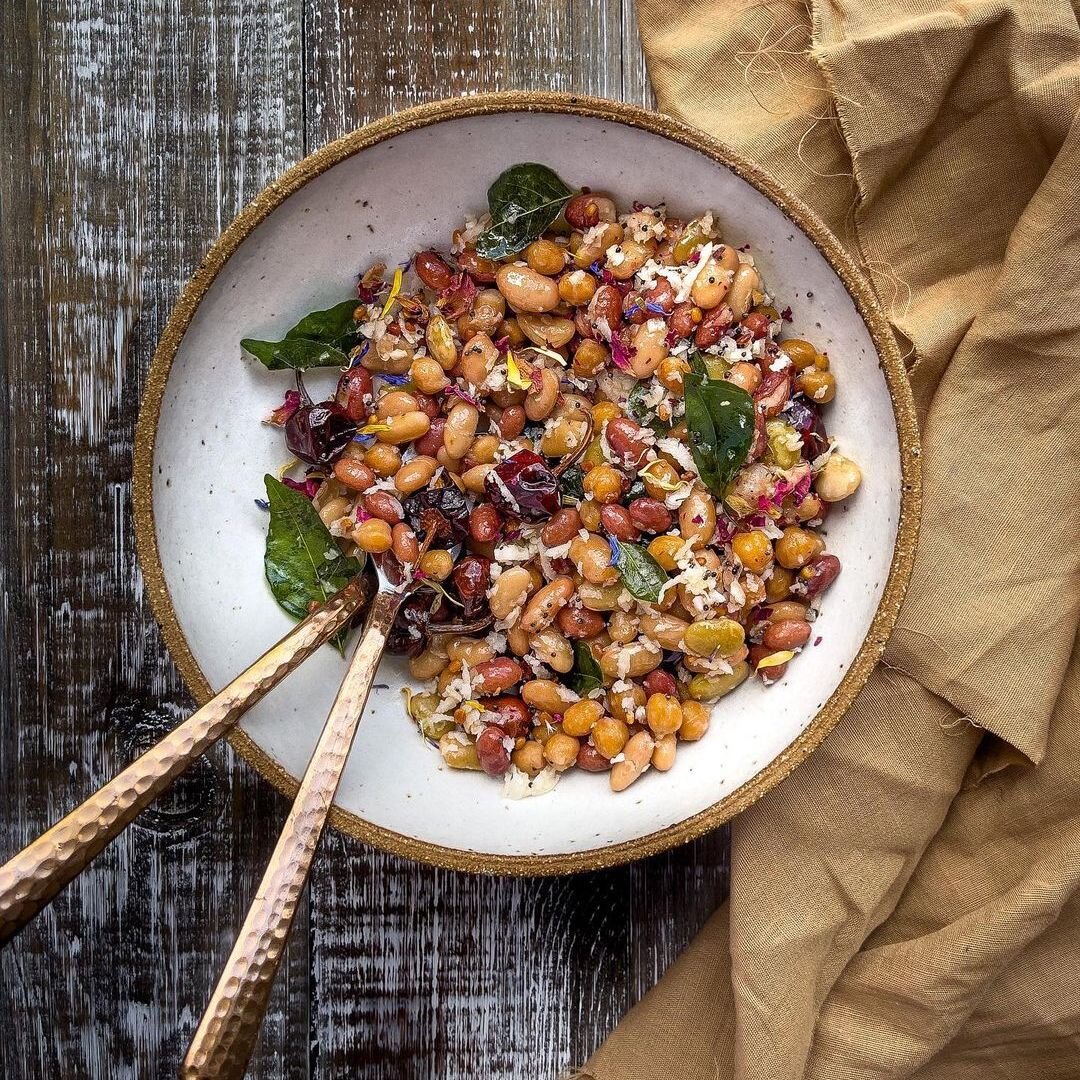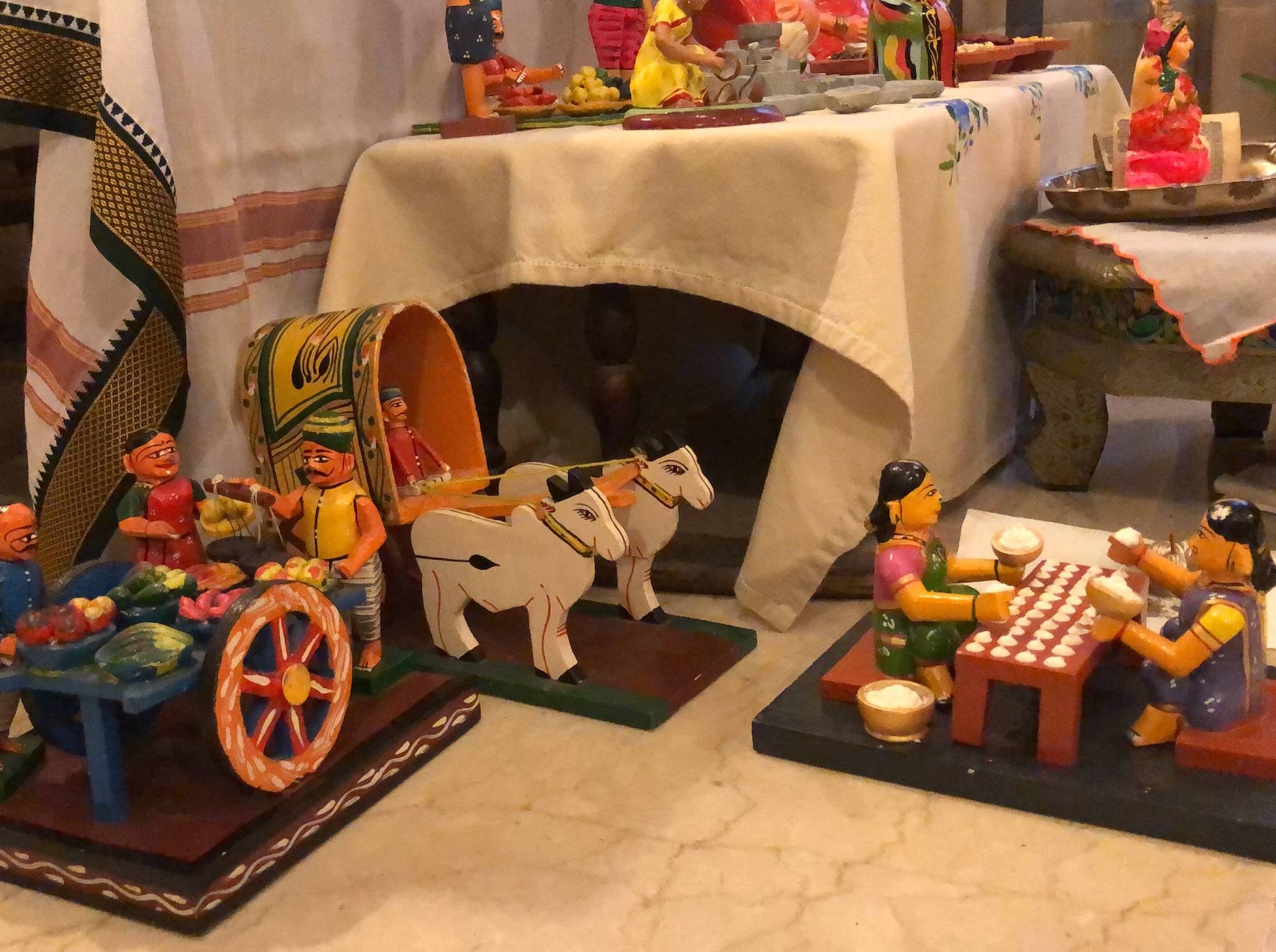Golu & A Side of Sundal this Navratri

Sharmila Vaidyanathan explores the cultural traditions of Navratri’s 2 most popular traditions — golu and sundal.
Tell me you’re celebrating Navaratri, without telling me you’re celebrating Navaratri.
I’d post a picture of sundal.
Festivals have interesting ways of announcing their arrival. There are the material elements, of course, but each festival carries with its own distinct, evocative trait. No matter how many lamps surround me, it never really feels like Deepavali until the aroma of ginger, pepper, carom seeds and jaggery cooking in ghee, wafts through the kitchen. The quintessential Deepavali legiyum — a digestive paste, eaten first thing in the morning, is what symbolizes the arrival of the festival of lights, to me. When the hum of sizzling oil dotted with seedais (crispy balls made of rice flour) fills my ears, I know for sure that we are celebrating Krishna Jayanti. And when pressure cookers get to work at 3 pm, their whistles coinciding with my evening cup of coffee, it is time for sundal and Navaratri.
A very elemental description of sundal would be to say that it is a south Indian dish made with legumes, spices, coconut, and curry leaves. A more functional description would be that the sundal is a low-fat, protein-heavy snack that can be put together in a jiffy (soaking time not included, of course). While both are accurate, I am not sure they do justice to sundal. After all, encapsulating the zeitgeist of a south Indian Navaratri, a symbol of austerity amidst the festive fervour, it is an effortless dish that demands little from its maker, and one that has stood the test of time.
Celebrated over a period of nine days in the Tamil month of Purattasi, usually between September and October, the festival of Navaratri remains one of my personal favourites. During Navaratri, both material and evocative elements come together seamlessly for nine days of festivities, and a significant part of this is the Navaratri golu (or kolu).
The golu is a makeshift doll display that is set up on the day of the new moon, the day prior to the start of Navaratri. As children, my sister and I would wait excitedly for our father to bring down the box containing the golu bommais (dolls in Tamil) from the loft, which were then displayed on an odd-numbered, step-like arrangement. Before perfectly level, ready-made golu stands came into our lives, we fashioned steps using what was around the house — wooden stools, coffee table, stacks of newspaper and cardboard boxes. This makeshift chaos was carefully concealed with old sarees or a white dhoti, bringing the arrangement to life.
Black chickpea with coconut, cumin and chilies by @cuminandcake
Image credit. @just.a.pinchofsalt
Four bean sundal by @thewelldressedtales
Pachai Payaru Sundal by @fusiontaste_buds
Traditional golu dolls made of wood, clay or paper machete were arranged on the steps carefully, hiding many imperfections along the way. Every day, my mother and grandmother would prepare a particular variety of the sundals, using a different legume. The sundal was offered to the golu before the rest of the family, and guests who came to see the arrangement, got a taste of it. These are the traditions that I carry forth even today.
In the book Nine Nights of the Goddess: The Navaratri Festival in South Asia, distinguished professor and scholar Vasudha Narayanan explores the history of golu and writes that domestic golus are probably inspired by royal Navaratri celebrations from the Vijayanagara period. Based on documented accounts from European travellers, Narayanan explains that the step-structure is a miniature replication of the tiers erected for the king and his subordinates, from where they observed the festivities. The term kolu, she elaborates, means sitting in state, is indicative of the royal darbar, and references to deities holding courts are also found in classical music verses. At some point, a domestic version of this practice manifested itself across homes in south India, establishing the golu ritual. Narayanan also explains that apart from the golu during Navaratri, in parts of south India, especially Andhra Pradesh, golu is also part of the harvest festival of Pongal.
It is unclear at what point sundal entered this milieu, but the ‘why sundal’ question was met with several answers. Narayanan writes, “Sundal is a slightly salty, salad-like dish, which is made with different kind of beans, such as garbanzo, every day, during the festival. The goddess, to whom the kolu is dedicated, is said to favor beans.” Women in my family believe that Navaratri is also time for fasting, and sundal is a dish that provides sustenance in these times. In the chapter Dolls and Demons, cultural researcher Ina Marie Lunde Ilkama explains that the sundal is also meant to be an “energetic food”, and women eat it as a way to empower the Goddess in her battle against the demons.
Navaratri is a celebration of the triumph of good over evil, and is centred around the Goddess in all her incarnations — Lakshmi, Saraswati and Durga. Unlike other festivals, where women are relegated to the kitchens as the rest of the family enjoys the festivities, Navaratri puts women in the spotlight. They are special guests invited to view the golu, partake in the prasadams, and young girls are worshipped as incarnations of the Goddess herself. Women dress in their finest sarees when they go ‘golu-hopping’ and exchange gifts. Visitors often sing songs and narrate stories in front of the golu. When the steps go up, there is never a dull moment in the house.
Festival foods, as is often the case, are a lot of work. In south India, efforts are doused in hot oil, showered with rice flour and soaked in sticky jaggery and sugar syrups. In the midst of this all, the sundal can seem like a misfit.
From a culinary standpoint, there isn’t much to say about sundal. Soaked and cooked lentils are sautéed in oil along with mustard seeds, curry leaves, a dash of freshly grated coconut. Sundal is spiced with a powder that usually contains split Bengal gram, dried red chillies and coriander seeds. The proportion of ingredients for sundal podi varies varies from kitchen to kitchen, and some homes skip it all together, preferring to let the natural flavour of coconut and the heat of dry red chillies carry the sundal.
As you can see, there isn’t much room for error with sundal. But in kitchens where lentils are cooked to a mushy consistency, to blend in seamlessly with sambhar, rasam and the other dals, sundal tests you in the most fundamental way. With white or black chickpeas, the process goes without a hitch, which is why these are my go-to choice of lentils on days I have people visiting. But when I find myself in the split Bengal gram or green gram territory, I am on high alert, soaking and cooking them with vigilance, so they stay fluffy and separate.
Like all festivals, Navaratri is also witnessing the winds of change. Doors were once open for golu viewing for all 9 days, but now, golu invitations are restricted. Traditional golu arrangements have gods and goddesses on the first few steps, followed by kings and queens, with the last steps dedicated to showcasing the nuances of everyday life. While these arrangements vary between homes, people also use the space around the golu to recreate their favourite mythological stories, cricket matches, even weddings to scenes from life in general. Two years ago, when I visited the golu at a friend’s house, I was surprised to find that her sons had worked on a diorama to highlight air pollution. Blackened cotton clouds and painted smoke from miniature vehicles brought the issue to life. Last year, dolls adorned masks, reflecting safety measures for the pandemic. Talk about spreading the message.
Photos by Deeptha Vivekanand
"Kolu also has its origins in supporting the local doll-making communities, which is probably what mandates the buying of one new item every year, as a way of growing your kolu collection," explains professional storyteller and educator Deeptha Vivekanand. "From those humble origins, kolu has become a lot more about the stories that families want to share with the world. Kolus now reflect family interests and legacy, as many of the dolls are handed down over generations. Every family has their own take on the festival, which is why you see a lot of people investing in thematic kolus. Along with oral storytelling, you also experience visual and immersive storytelling. The kolu becomes a very important frontispiece, so to speak."
Vivekanand says that Navaratri holds a special place in her home, for the simple reason that at the core of the kolu is storytelling. “I have vivid memories of going kolu-hopping with my grandmother, and we would come home with a stash of sundals from all the houses we visited. We would then sit and compare notes – whose sundal was better, whose was cooked well, whose was overcooked, who skimped on the soaking,” she laughs.
Over the years, the sundal-sphere has gone on to incorporate more lentils than the usual suspects, making the dish all the more interesting. When I posted a Rajma sundal on Instagram, a Punjabi friend of mine, who grew up in the south, commented that this sundal is representative of her life. Popular south Indian food blogger Sharmis Passions has a dedicated section for Navaratri dishes which includes everything from corn sundal, sabudana sundal, and carrot and dried yellow peas sundal, among other varieties. While other festival foods have seen exciting modern variations like the chocolate modaks and pedas, the Bournvita burfi and the oats laddoo, sundal remains rooted in its profound simplicity.
But sundal’s profundity goes beyond Navaratri itself. When a close relative underwent a life-altering surgery, the snack became a mandatory part of his diet during convalescence. The festival food turned into a conduit of health and hope. After my mother tested positive for Covid a few months ago, my parents had food delivered in, and every day, along with lunch, they got a packet of sundal. My mother would save it for later, so she could snack on it with coffee. The sundal restored some semblance of normalcy in her day. The thenga-manga-pattani or dried peas-raw mango-and-coconut sundal is a favourite beach snack. No matter where it is eaten, this sundal evokes languid evenings by the sea.
Against the flamboyance of Navaratri festivities, in hospital cups burdened with hope, or seasoned with salty sea breeze by the beach – sundal maintains a self-effacing presence, spreading hope and cheer. And just for that, it deserves a special shoutout.
Sharmila Vaidyanathan is a freelance writer based in Bangalore, India. She explores food entrepreneurship, sustainability, and environmental conservation through her writing. Her work has appeared in Nature inFocus, Scroll, Goya, Hakai Magazine, Whetstone, Inkline and others.
This feature is part of The Beautiful Indian Kitchen campaign, a year-long celebration of the Indian kitchen and its various facets — both traditional and modern.
ALSO ON THE GOYA JOURNAL














